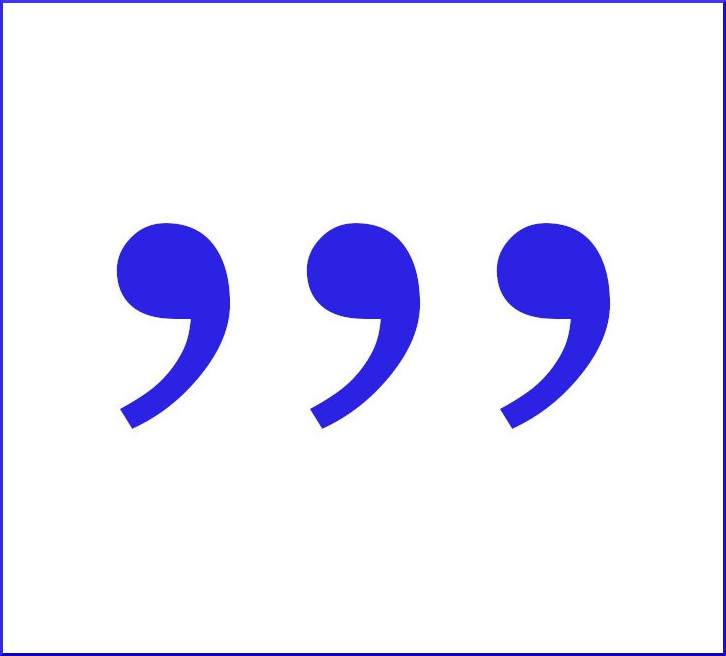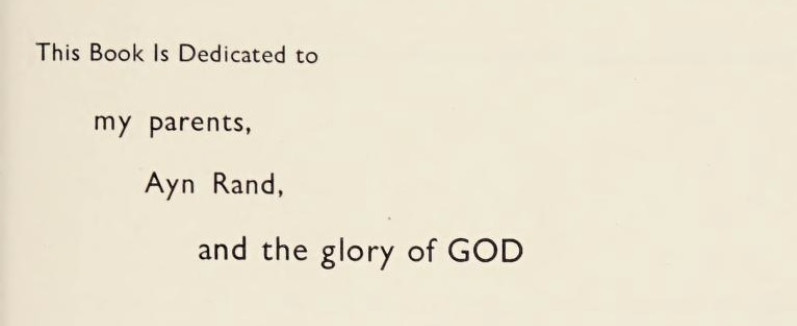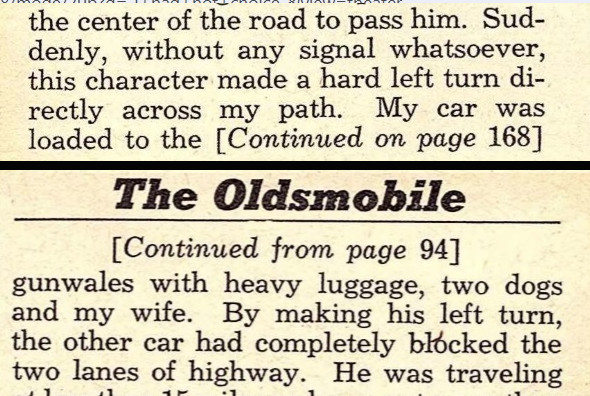Ayn Rand? R. M. Bevensee? Merle Haggard? Tom McCahill?

Question for Quote Investigator: Consider the following list of four items: octopus, pineapple, pencil, and kangaroo. The final comma is referred to as a serial comma, and some style manuals argue that it should be omitted. This comma is also called an Oxford or Harvard comma. The omission of serial commas occasionally leads to hilarious results. Here are four examples I have seen:
(1) Book dedication: Dedicated to my parents, Ayn Rand and God.
(2) His global tour include encounters with Nelson Mandela, an 800-year-old demigod and a dildo collector.
(3) Among those interviewed were his two ex-wives, Kris Kristofferson and Robert Duvall.
(4) My car was loaded to the gunwales with heavy luggage, two dogs and my wife.
The first example suggests that the author was the product of a union between a famous philosopher and a deity. In this comical interpretation, the phrase “Ayn Rand and God” functions as an appositive which provides a further description of the noun “parents”. Hence, one parent is Ayn Rand, and the other parent is God.
The other three examples also engender ludicrous interpretations. Did a naïve writer construct any of these statements? Which of these statements was crafted by a humorist?
Reply from Quote Investigator: The earliest match known to QI for the first statement appeared in the 1964 book “Electromagnetic Slow Wave Systems” by R. M. Bevensee who was an Assistant Professor of Electrical Engineering, University of California Berkeley. The dedication was written on four lines, and the author employed a serial comma. Boldface added to excerpts by QI:1
This Book is Dedicated to
my parents,
Ayn Rand,
and the glory of GOD

QI conjectures that the lines above inspired an unknown person to construct an apocryphal shortened comical version without the serial comma. In 1997 a message posted to the Usenet newsgroup alt.books.reviews contained an instance of this joke:2
Among copyeditors, a favorite argument in support of the “serial comma” (i.e. the comma that comes just before the ‘and’ in a series of three items or more) is demonstrated by a supposed dedication in someone else’s work. Whether apocryphal or not I dunno. Anyway, it was supposedly published as —
. Dedicated to my parents, Ayn Rand and God
In November 1998 “The Sunday Times” of London published a capsule summary of a television series called “Planet Ustinov” hosted by the British actor and raconteur Peter Ustinov. The following passage provided a genuine example of unintentional humor because it omitted the serial comma:3
By train, plane and sedan chair, Peter Ustinov retraces a journey made by Mark Twain a century ago. The highlights of his global tour include encounters with Nelson Mandela, an 800-year-old demigod and a dildo collector.

In December 1998 “The Guardian” printed a collection of items from other newspapers titled “Your Favourite Cuttings”. The clipping above appeared with the following description:4
Nelson Mandela as you have never seen him before. From an unfortunate television preview in the Times, November 22
In 2005 the apocryphal dedication mentioning Ayn Rand continued to circulate via the book “The Revenge of Anguished English: More Accidental Assaults Upon Our Language” by Richard Lederer:5
If you ever need an exhibit to bolster your argument for use of the serial comma — the one that’s inserted before and, as in “red, white, and blue” — simply turn to the following book dedication: “To my parents, Ayn Rand and God.”
In 2010 the “Los Angeles Times” published a piece about a new documentary covering the life of country music singer and songwriter Merle Haggard. Beneath the picture of Haggard was a caption that provided another genuine example of unintentional humor:6
MERLE HAGGARD: The documentary was filmed over three years. Among those interviewed were his two ex-wives, Kris Kristofferson and Robert Duvall.

In 2012 columnist Robert Fulford of the “National Post” in Toronto, Canada published an article about the Oxford comma:7
One member of the pro-Oxford faction claims to have found the ultimate proof in a line from a newspaper story about a documentary on Merle Haggard: “Among those interviewed were his two ex-wives, Kris Kristofferson and Robert Duvall.” In that sentence (traditionalists argue) one curly little Oxford comma after Kristofferson would have cleared up what otherwise looked like a bizarre error.
In 2014 “The Times” of London pointed to the 1998 example:8
Why punctuation matters
“Highlights of [Peter Ustinov’s] global tour include encounters with Nelson Mandela, an 800-year-old demigod and a dildo collector” (The Sunday Times TV listings, 1998)
In March 1960 “Mechanix Illustrated” published an article entitled “The Oldsmobile” by Tom McCahill. The author described an incident during which he narrowly avoided an accident:9
A guy in a little old car was creeping along ahead of me with one wheel in the gutter. I pulled toward the center of the road to pass him. Suddenly, without any signal whatsoever, this character made a hard left turn directly across my path. My car was loaded to the gunwales with heavy luggage, two dogs and my wife. By making his left turn, the other car had completely blocked the two lanes of highway.

An August 1960 “Mechanix Illustrated” published a letter sent to Tom McCahill about the ambiguity of the sentence he composed in March 1960:10
Just read your report on the ’60 Olds and was struck by the statement, “My car was loaded to the gunwales with heavy luggage, two dogs and my wife.” A series of articles in a sentence should be separated by commas to clarify the meaning—or were you describing the heavy luggage as being the two dogs and your wife?
McCahill responded to the letter with the simple two word interrogative: “What else?”
In summary, current evidence indicates that the first example is apocryphal. The second example is genuine; it appeared in “The Sunday Times” in 1998. The third example is genuine; it appeared in the “Los Angeles Times” in 2010. The fourth example is genuine; it appeared in “Mechanix Illustrated” in 1960.
Image Notes: Illustration of three commas.
Acknowledgement: Thanks to Language Log, Richard Lederer, Ben Yagoda, and Benjamin Dreyer who have all presented examples from this set to illustrate the serial comma. Special thanks to @jondanziger, Stephen Goranson, @miss_reading, @chris_bloke, and @BillEllson who all helped QI obtain information about citations for this article. Also, thanks to David Daniel who told QI about a typo. In addition, thanks to James Landau who mentioned the 1960 example and pointed toward the two citations.
Update History: On July 15, 2024 the March 1960 citation was added to the article. On July 16, 2024 the August 1960 citation was added to the article.
- 1964 Copyright, Electromagnetic Slow Wave Systems by R. M. Bevensee (Assistant Professor of Electrical Engineering, University of California Berkeley), (Dedication page of book), Unnumbered Page, John Wiley & Sons, New York. (Verified with scans) ↩︎
- February 3, 1997, Usenet discussion message, Newsgroup: alt.books.reviews, From: ed.n…@syslink.mcs.com, Subject: ayn rand? (Google Groups Search; Accessed December 18, 2022) link ↩︎
- 1998 November 22, The Sunday Times, The week in view: Best Travelogue — Planet Ustinov, Quote Page 29, Column 3, London, England. (Gale Historical Archive of The Sunday Times) ↩︎
- 1998 December 19, The Guardian, Section: The Editor, Your Favourite Cuttings, Quote Page 10, Column 2, London, England. (Newspapers_com) ↩︎
- 2005, The Revenge of Anguished English: More Accidental Assaults Upon Our Language by Richard Lederer, Chapter: Extra-Tasty Grammar Crackers, Quote Page 163, St. Martin’s Press, New York. (Verified with scans) ↩︎
- 2010 July 21, Los Angeles Times, Television Review: Haggard — candid as ever by Randy Lewis, Quote Page D10, Column 2, Los Angeles, California. (Newspapers_com) ↩︎
- 2012 September 11, National Post, Grammer, grammar & preppy vampires by Robert Fulford (Notebook), Quote Page AL9, Column 5, Toronto, Ontario, Canada. (Newspapers_com) ↩︎
- 2014 February 8, The Times, Why the comma is heading towards its own full stop by Oliver Moody, Quote Page 21, Column 1, London, England. (Gale The Times Archive) ↩︎
- 1960 March, Mechanix Illustrated, The Oldsmobile by Tom McCahill, Start Page 92, Quote Page 94 and 168, Fawcett Publications, Greenwich, Connecticut. (Verified with scans) ↩︎
- 1960 August, Mechanix Illustrated, Section: Mail For McCahill, Letter from: Onus M. Comer of Novato, California, Start Page 49, Quote Page 52, Column 1, Fawcett Publications, Greenwich, Connecticut. (Verified with scans) ↩︎